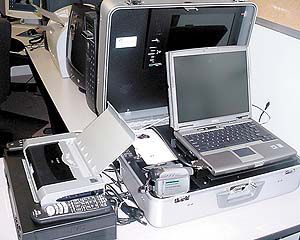| The Helper Police Department recently received some equipment to help them enhance video that is taken in the field for investigation purposes. |
Helper police recently received a grant which will assist the department in preparing an analyzing video surveillance. The grant was part of the Commercial Equipment Direct Assistance Program under the United States Department of Homeland Security.
Equipment included as part of the grant includes:
•Laptop with software.
•Acadia I Vision Accelerator Board, which provides state-of-the art, dedicated computing power for real-time stabilization.
•Monitor for better viewing of real time video.
•Camcorder for videotaping or recording stabilized video.
•Color printer.
•VCR for viewing videotapes or recording stabilized video.
•Accessory case.
Paid for as part of the grant, Chief George Zamantakis flew to Orlando, Fla., to attend training for the system. The grant paid for airfare, meals, rooms and the video system itself, valued at $50,000.
The system provided, called Video Detective, is the most advanced surveillance and video enhancement tool available for law enforcement, explained Zamantakis.
The system provides a complete, portable system boasting the most powerful vision chip available. This provides agencies with access to the equipment with an edge for real time stabilization and image enhancement. The system is used for surveillance to stabilize shaky video in real time or set up as a forensic workstation and enhance video images to correct for interlacing, reduce noise and improve resolution. Once enhanced, video clips can be immediately distributed or e-mailed as files, individual frames and panoramic scenes which can be printed as still images.
After receiving training, the Department of Homeland Security shipped the equipment to the city. Because the equipment was provided as part of a grant program, Helper’s police force will have access to some of the latest technology without having to absorb the costs to acquire the new system,
“Without the grants that are available to law enforcement agencies such as Helper City, we would never be able to afford this type of equipment will greatly enhance our capabilities with investigations,” said Zamantakis.
He explained that Helper was selected from other applicants including law enforcement agencies, fire departments and other emergency response teams which are able to demonstrate that the equipment will be used to improve the agency’s ability and capacity to respond to a major critical incident or improve its ability to work with other first responders. Some of the ways this can be accomplished include plans for sharing of equipment, joint training or use of equipment and joint operational planning, said Zamantakis.
The assistance program, which is operated by the DHS Preparedness Directorate, Office of Grants and Training, seeks to assist smaller communities in acquiring and using commercially available equipment to prevent, deter and respond to terrorist attacks, as identified in state homeland security strategies.
“This competitive program is a direct assistance program, not a grant program, and [Office of Grants and Training] will provide the equipment and technical assistance directly to the selected jurisdictions,” explained Helper’s police chief.
As part of the assistance program, agencies can receive equipment such as personal protective equipment; rescue tools; thermal imaging, night vision and video surveillance tools; chemical, biological and radiological detection tools; information technology and risk management tools; interoperable communication gateways.
Helper’s police department has been able to take advantage of grants from the DHS and other state and federal agencies. Many of the equipment needs of the department have been met by grants.
Zamantakis explained that the equipment that Helper city has obtained will be available to any agency in the state that needs assistance, or use of, video surveillance analysis tools.

